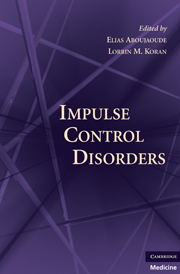Book contents
- Impulse Control Disorders
- Impulse Control Disorders
- Copyright page
- Dedication
- Contents
- Contributors
- Acknowledgments
- Introduction
- Section I Acquisitive Impulses
- 1 Compulsive Buying: Clinical Aspects
- 2 Compulsive Buying: Cultural Contributors and Consequences
- 3 Kleptomania: Clinical Aspects
- 4 Kleptomaniaand the Law
- 5 Pathological Gambling: Clinical Aspects
- 6 Pathological Gambling: Promoting Risk, Provoking Ruin
- 7 Cash and Casinos: An Indian Perspective
- Section II Pellicular Impulses
- Section III Information-Seeking Impulses
- Section IV Sexual and Aggressive Impulses
- Appendix I: Treatment Guidelines
- Appendix II: List of Scales and Assessment Instruments
- Index
5 - Pathological Gambling: Clinical Aspects
from Section I - Acquisitive Impulses
Published online by Cambridge University Press: 06 July 2010
- Impulse Control Disorders
- Impulse Control Disorders
- Copyright page
- Dedication
- Contents
- Contributors
- Acknowledgments
- Introduction
- Section I Acquisitive Impulses
- 1 Compulsive Buying: Clinical Aspects
- 2 Compulsive Buying: Cultural Contributors and Consequences
- 3 Kleptomania: Clinical Aspects
- 4 Kleptomaniaand the Law
- 5 Pathological Gambling: Clinical Aspects
- 6 Pathological Gambling: Promoting Risk, Provoking Ruin
- 7 Cash and Casinos: An Indian Perspective
- Section II Pellicular Impulses
- Section III Information-Seeking Impulses
- Section IV Sexual and Aggressive Impulses
- Appendix I: Treatment Guidelines
- Appendix II: List of Scales and Assessment Instruments
- Index
Summary
- Type
- Chapter
- Information
- Impulse Control Disorders , pp. 51 - 74Publisher: Cambridge University PressPrint publication year: 2010
- 2
- Cited by



